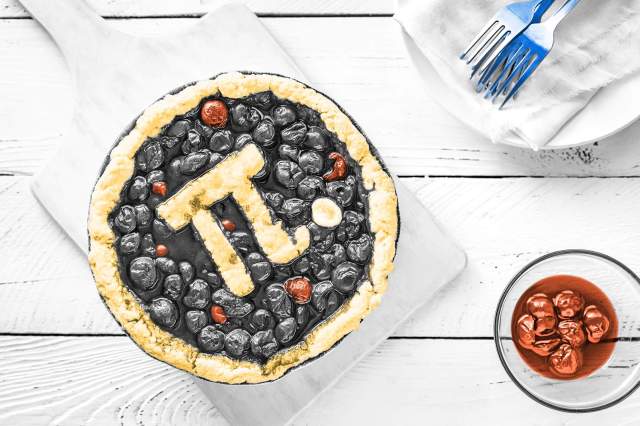
The First Pi Day Took Place in the 1980s
The first known celebration of Pi Day took place in 1988 at San Francisco’s Exploratorium. Physicist and curator Larry Shaw, aka the Prince of Pi, came up with the idea at a staff retreat and organized the museum’s inaugural event, which included fruit pies and tea served at 1:59, the three digits in pi after 3.14. Later celebrations included “pi-rades” of museum staff and visitors — each with a subsequent digit of pi — marching around the building behind Shaw, who upheld the tradition until his death in 2017. The Exploratorium still holds Pi Day events every year, with lectures, concerts, pi processions, and (of course!) dessert.

Universities Celebrate Pi Day in Their Own Unique Ways
Since that first Pi Day in the 1980s, other institutions have adopted the holiday as their own, complete with math-themed celebrations and traditions. St. Bonaventure University, for one, has its Pi Day itinerary scheduled by the minute to correspond with the digits of pi. The festivities start on March 14 at exactly 1:59 p.m. and conclude 2 hours and 65 minutes later — symbolic of 3.14159265.
Not to be outdone, MIT posts its undergraduate admissions decisions for prospective students every year on Pi Day, often with cleverly strategic timestamps. In 2012, for example, the decisions were released at 6:28 p.m. to represent and approximate the mathematical constant tau. Three years later, they were posted at 9:26 a.m. — 3/14/15 at 9:26, corresponding to 3.1415926. And more recently, in 2020, they were made available online at 1:59 p.m., again to match the digits of pi.

Pi Day Is Also Albert Einstein’s Birthday
The town of Princeton, New Jersey, celebrates Pi Day in conjunction with the birthday of one of its most famous former residents: Albert Einstein, who was born in Germany on March 14, 1879. The festivities include walking tours of Einstein’s favorite hangouts, a pi recitation competition, pie tastings, and even an Einstein look-alike contest. (Truly a genius way to celebrate.)
March 14 also happens to mark the anniversary of the death of another esteemed physicist, Stephen Hawking, who passed away at the age of 76 on that day in 2018. It’s not the only link between two of the 20th century’s most influential scientists, but it’s certainly an interesting cosmic coincidence.
More Interesting Reads

Pi Day Is an Excuse to Get Cheap Pizza
Pi Day doesn’t really have anything to do with the kind of pie we eat — unless you count the fact that pies are traditionally circles — but that hasn’t stopped pie shops and other businesses from cashing in on the craze. Many restaurants offer discounts on pie on March 14, as well as specials on pizza, cake, and other circular treats. In the past, brands including 7-Eleven, CiCi’s Pizza, and even the Honey Baked Ham Company have gotten in on the action. If you ask us, any holiday that offers whole pizzas for $3.14 is one worth celebrating.

Pi Day Was Recognized by Congress in 2009
In the two decades after Larry Shaw’s first pi-themed celebration at the Exploratorium, Pi Day became such a widespread observance that on March 12, 2009, the U.S. House of Representatives passed a non-binding resolution supporting “the designation of a Pi Day and its celebration around the world.” The measure was backed by various science and technology organizations, including the Association for Competitive Technology and the American Chemical Society, in a lighthearted effort to encourage students to further engage with mathematics.
Pi Day has also garnered global recognition via UNESCO, which celebrates March 14 as the International Day of Mathematics.

There’s More Than One Day to Celebrate Pi
March 14 isn’t the only date on which pi is celebrated. Some people also observe Pi Approximation Day on July 22, since the fraction that approximates pi is 22/7, which is that date written in the day/month format. Others cleverly honor pi on November 10, as it’s the 314th day in a non-leap year. A few even celebrate Two Pi Day (or Tau Day, as it’s also known) on June 28. Tau is the ratio of a circle’s circumference to its radius, equal to 2π or approximately 6.28 — making June 28 the perfect occasion for double servings of pi(e).












